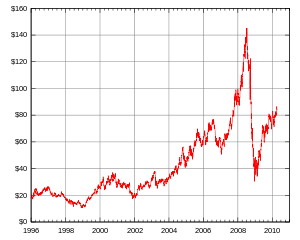
The US economy is at least twice as efficient in energy use today as it was two decades ago
There is growing euphoria over America’s energy future. Energy experts around the globe have been claiming that the US will gain energy independence in the next eight years. Optimists have even gone on to claim that America’s energy independence will lead to global energy independence.
The primary basis for the first of these two claims is a series of technological breakthroughs, the most important of which is the application of what is called shale gas technology to extract oil from rock. Experts and journalists are so impressed by this technological breakthrough that they have credited it for lowering US dependence on imported oil by aquarter from 60% of the country’s overall oil consumption a few years ago to 46% in the current year.
Has there really been such afantastic rise in domestic production to account for thisdramatic fall in US dependence on imported oil? Well, when something sounds too good (to be true), it is wise to revisit facts.
There has certainly been a decline in US oil imports, and there is certainly a major technological breakthrough in oil extraction. But the current decline in imports has nothing to do with this breakthrough; the recent decline in imports is almost entirely demand-driven.
So, if you have to thank someone, alas, it would have to be the Great Recession or the housing bubble that caused the recession or the financial meltdown that preceded the recession. Take your pick. The US consumption of oil has declined by 13% since the start of the Great Recession. There is indeed some increase in production – less than half amillion barrels per day – but that’s like a drop in the bucket of US oil imports of 11.5 million barrels per day. Okay, not a drop, but not more than a few teaspoons.
What has been missing from the current energy euphoria is the story from the demand side. The US economy has been staggering under the Great Recession for close to five years now, with the unemployment rate being 9% or higher for three consecutive years.
More than half the country’s working-age population has experienced work-related hardships – unemployment, cut in wages and involuntary cutbacks in paid hours – and many have been impacted by negative home equity, arrears on their mortgage payments or foreclosure. All this has had the cumulative impact of lowering overall consumption, including energy consumption.
Energy conservation has always been a dirty word in US politics. But conservationists have made some breakthroughs over the years. The US economy is at least twice as efficient in energy use today as it was two decades ago. US Energy Information Administration’s forecast for the next quarter century is a steady decline inper-capita energy use driven by more efficient energy use, structural changes and decarbonisation.
Forecasts are just forecasts, however. Based on a number of scenarios relating to energy prices, technological, economic and demographic changes, and future oil discoveries, forecasts change with these scenarios. Oil forecasts have been notoriously slippery, yet such notoriety has not stopped experts and organisations from making them.
Indeed, forecasting oil prices and production is a successful business, though not for the accuracy of the estimates. In 1999, The Economist magazine ran a cover story predicting that the price of oilwill plummet to $5 a barreland that the world economy will be ‘drowning in oil’. In the 13 years since the infamous forecast, the actual price of oil has been four to 30-times higher.
We hope that the current forecasts on US energy independence are based on firmer grounds. Experts claim that within the next eight years, shale reserves in the US will produce three million barrels a day and oil sands production in Canada will double from 1.5 to 3 million barrels per day. If these projections turn true, US may not have to import oil from outside the western hemisphere.
Both these sources of oil are, however, unconventional and, therefore, expensive. Production is slow and has environmental consequences. For instance, horizontal drilling and hydraulic fracturing is known to affect underground water. According to energy expert Daniel Yergin, extraction of oil from Canadian oil sands releases 5-15% more carbon dioxide than the average barrel of oil used in the US.
Thus, while energy independence is a temping goal and there are more long-term sources of oil available in the western hemisphere, whether it is economic to produce oil from these sources after adjusting for environmental costs will be an important factor that will determine the exploitation of these sources.
Finally, a few words on the forecast that US energy independence will lead to global energy independence. Americans guzzle more energy than anyone else on our planet. Therefore, a reduction in American oil imports will reduce pressure on oil prices and make more energy available for the rest of the world.
Read more . . .
Bookmark this page for “American energy supply” and check back regularly as these articles update on a very frequent basis. The view is set to “news”. Try clicking on “video” and “2” for more articles.








